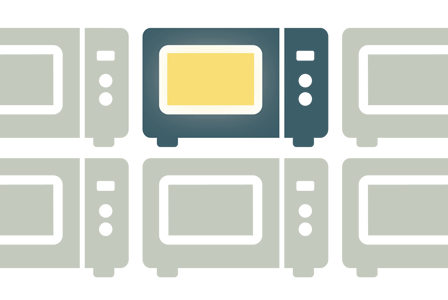
Whether microwaves are safe has been debated since their introduction into the kitchen in 1947. We look at the facts on microwave ovens.
Microwave ovens have been around for decades. Terminology such as “radiation” and slang expressions such as “nuking” have helped to shroud these ovens in an ongoing controversy.
In Canada 90 percent of households are estimated to own these appliances, yet consumers may still wonder whether microwave ovens pose a danger to their health. What’s the truth behind the safety of microwave cooking?
What are microwaves?
Microwaves are a form of electromagnetic radiation. They are part of the electromagnetic spectrum that includes radio waves, infrared (we know it as heat from the sun), visible light, ultraviolet light, X-rays, and gamma rays.
This non-ionizing radiation has the energy to cause atoms within molecules to vibrate, but not enough energy to remove electrons from the atoms.
During the development of radar in World War II, an engineer accidentally discovered that the radar waves used to detect planes could also heat food. The first microwave oven, called the Radarange, came out in 1947. The first consumer, countertop model came out 20 years later. Microwave ovens soon became a popular household appliance.
How microwave ovens work
Every microwave oven has a magnetron which produces the microwaves. The microwaves are reflected within the metal interior of the oven, pass through containers such as glass and plastic, and are absorbed by the food. The microwaves cause the molecules in the food to vibrate (especially those of water, fats, and sugars). The vibration results in friction which creates heat.
The controversy
Many people believe that microwave ovens are unsafe. They contend that:
- microwaves alter food composition, producing toxins and carcinogens
- the nutritional content of foods are lost or altered so that there is very little benefit to the consumer
- microwaves produce electromagnetic fields (EMF) that negatively affect people
Many who support these claims cite a few studies and one seemingly related death. Unfortunately, these studies are old, unreplicated, and have never been published in peer-reviewed journals (a necessary litmus test for all health-related claims in alive).
An unusual lawsuit
Norma Levitt’s death in 1991 resulted in a lawsuit against the Oklahoma hospital and staff who operated on her. The lawsuit alleged that blood warmed in a microwave oven was used in a transfusion following a routine hip replacement on Levitt. The hospital maintained the cause of death was from a blood clot and not from the microwaved blood. The court found the hospital and staff not guilty.
From a scientific point of view, there is no correlation between microwaved blood that is injected into the bloodstream and the idea that microwaves must be altering food which, if ingested, could be deadly. Bob Schiffmann, a microwave consultant and process developer since 1961, believes that “the Web is filled with misinformation that leads to concerns.”
The facts
High levels of microwaves can cause cataracts, burns, and temporary sterility, but the emissions from microwave ovens are far below these levels and do not pose a danger. Professor Tony Muc of the University of Toronto states that, “the [Health] guidelines incorporate significant safety factors which further reduce any possible risk [to].”
Muc explains that microwaves heat food by “heating the water molecules that form the bulk (much more than half) of most foods. The other molecules in the food are like peas in a pot of boiling water. They get hot from contact with the hot water but they are not degenerated or altered.”
There are no studies that conclude that consumption of microwave-heated foods will result in sickness or disease. In fact, Muc states that heating food in a microwave oven has “much the same sort of effect as that produced by infrared radiation [heat] under a broiler.”
To dispel the nutritional degradation myth, Schiffmann explains that all cooking affects the nutritional content of foods. This is because cooking involves raising the temperature of foods, and certain vitamins are sensitive to heat which can cause a reduction in nutritional content. In general, microwaving vegetables retains more of the nutrients than boiling as water is the culprit for most reductions in nutrients.
What are the dangers?
No dangers have been linked to cooking food using a microwave oven rather than using a conventional oven. The dangers with microwave ovens are similar to those of any other oven: over-cooking the food can reduce the nutritional content; and burns can result from skin contacting the hot food or container.
As Schiffmann puts it, “other than overheating foods, the only real danger of a microwave oven is dropping it on your foot.”
Dangerous micro-organisms
Microwave ovens can heat unevenly, particularly if the food is thick or dense. Manufacturers try to overcome this challenge with the use of carousels and fans. Care should be taken to stir the food during the cooking process or allow standing time (time taken for heat to pass through all of the food) so that all potentially dangerous micro-organisms are destroyed.
Current research
Microwave technology has come a long way from the early days of radar. With more and more consumer products on the market that use radio and microwaves, electromagnetic radiation and associated fields are being studied to determine if we are at risk from low-level exposures.
Current research and testing supports microwave oven safety for domestic use. When deciding whether to use a microwave, be critical about the information you find. If you use a microwave, always follow the manufacturer’s guidelines and routinely clean and inspect your microwave oven.
Ultimately, using a microwave is a personal choice. Despite current research to the contrary, some people believe further studies will reveal evidence of microwaves’ harm. But for those who enjoy the time-saving convenience a microwave oven offers, research seems to confirm that the controversy is more hype than fact.
Do microwave ovens leak radiation?
Microwave ovens may have minimal radiation leakage. Health Canada has strict limits which are far below those known to cause health concerns.
It is important to maintain your microwave to reduce the risk of leakage. The main source of potential leakage occurs at the oven door, so ensure the door is clear of debris and in
good working order.
Which containers are safe?
Glass and ceramic
- When cooking food in a microwave oven be sure to use containers designed for such a purpose.
- Glassware is a good choice.
- For ceramic ware plates, refer to the manufacturer’s directions to be sure.
Plastic
- Only use plastic containers labelled as microwave safe.
- If a container looks damaged or discoloured, do not use it.
- Plastic containers such as margarine and yogourt tubs are intended for one-time use and should not be used to cook food as they could melt and potentially leak chemicals into the food.
- Don’t use a container if you have any doubts about it being safe.
- Never use thin plastic storage bags, brown paper or plastic grocery bags, newspapers, or aluminum foil in the microwave.
- If using plastic wrap over your cooking container, ensure it doesn’t touch the food as it may melt once the food is heated.
- If you are going to store cooked food in plastic, make sure the food has cooled first and then refrigerate immediately.



